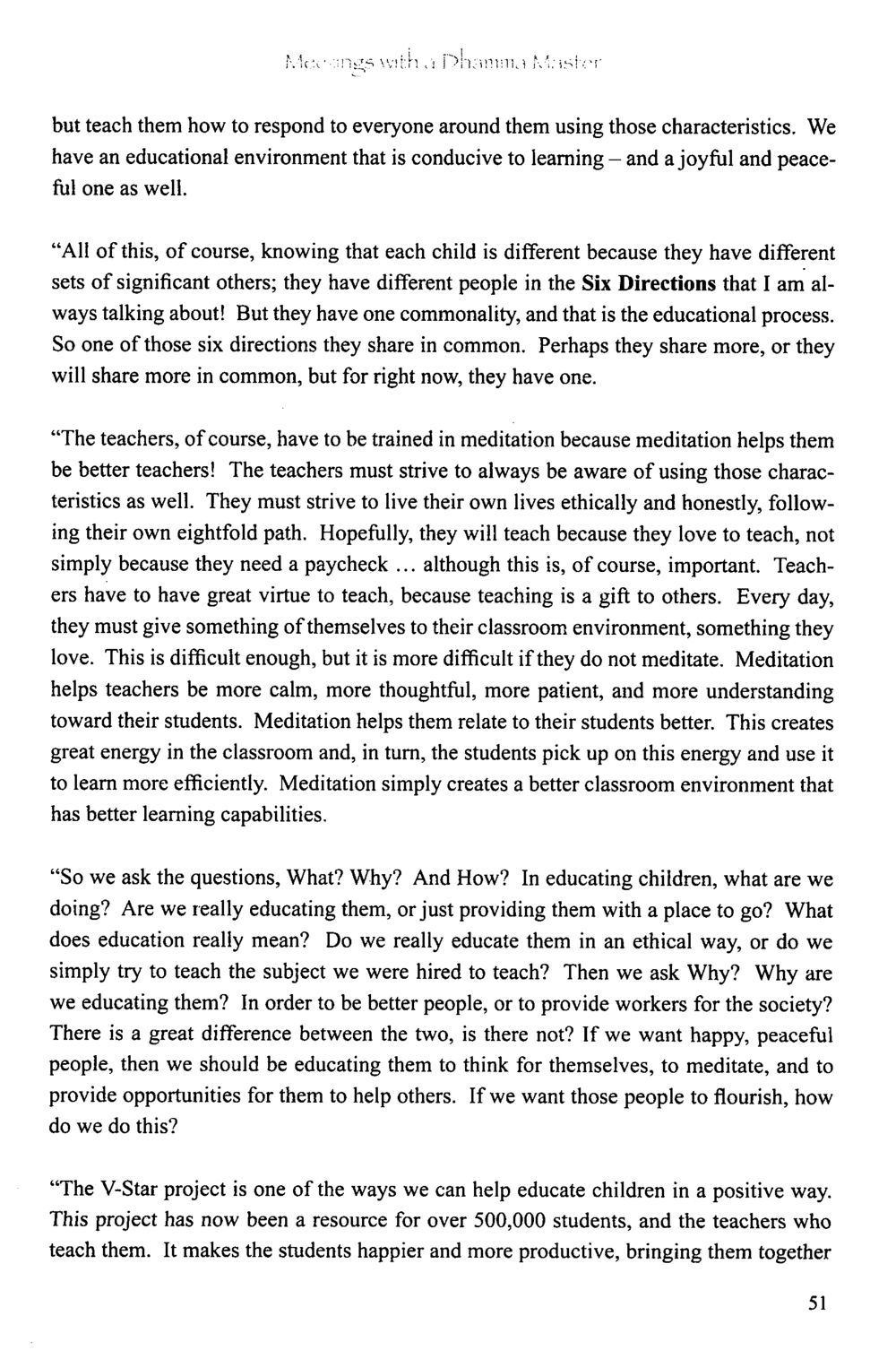The Importance of Meditation in Education : หน้า 55/164
The Meeting with a Dhamma Master : หน้า 55/164 Exploring the role of meditation in creating a nurturing educational environment for students and teachers alike.
3 ครั้ง

สรุปเนื้อหา
This text discusses how meditation enhances the teaching process by creating a peaceful and productive classroom atmosphere. It emphasizes the need for teachers to be trained in meditation to better relate to their students, fostering a joyful learning environment where children can thrive. The V-Star project is highlighted as a positive educational resource impacting over 500,000 students and teachers by promoting happiness and productivity in education. It poses critical questions about the purpose of education, urging educators to cultivate ethical thinkers rather than mere workforce members.
หัวข้อประเด็น
-Meditation in Education
-Teacher Training
-Classroom Environment
-Ethical Teaching
-V-Star Project
-Student Well-being
ข้อความต้นฉบับในหน้า
but teach them how to respond to everyone around them using those characteristics. We have an educational environment that is conducive to learning – and a joyful and peaceful one as well.
“All of this, of course, knowing that each child is different because they have different sets of significant others; they have different people in the Six Directions that I am always talking about! But they have one commonality, and that is the educational process. So one of those six directions they share in common. Perhaps they share more, or they will share more in common, but for right now, they have one.
The teachers, of course, have to be trained in meditation because meditation helps them be better teachers! The teachers must strive to always be aware of using those characteristics as well. They must strive to live their own lives ethically and honestly, following their own eightfold path. Hopefully, they will teach because they love to teach, not simply because they need a paycheck … although this is, of course, important. Teachers have to have great virtue to teach, because teaching is a gift to others. Every day, they must give something of themselves to their classroom environment, something they love. This is difficult enough, but it is more difficult if they do not meditate. Meditation helps teachers be more calm, more thoughtful, more patient, and more understanding toward their students. Meditation helps them relate to their students better. This creates great energy in the classroom and, in turn, the students pick up on this energy and use it to learn more efficiently. Meditation simply creates a better classroom environment that has better learning capabilities.
“So we ask the questions, What? Why? And How? In educating children, what are we doing? Are we really educating them, or just providing them with a place to go? What does education really mean? Do we really educate them in an ethical way, or do we simply try to teach the subject we were hired to teach? Then we ask Why? Why are we educating them? In order to be better people, or to provide workers for the society? There is a great difference between the two, is there not? If we want happy, peaceful people, then we should be educating them to think for themselves, to meditate, and to provide opportunities for them to help others. If we want those people to flourish, how do we do this?
The V-Star project is one of the ways we can help educate children in a positive way. This project has now been a resource for over 500,000 students, and the teachers who teach them. It makes the students happier and more productive, bringing them together
หน้าหนังสือทั้งหมด

1

2

3

4

5

6

7

8

9

10

11

12

13

14

15

16

17

18

19

20

21

22

23

24

25

26

27

28

29

30

31

32

33

34

35

36

37

38

39

40

41

42

43

44

45

46

47

48

49

50

51

52

53

54

55

56

57

58

59

60

61

62

63

64

65

66

67

68

69

70

71

72

73

74

75

76

77

78

79

80

81

82

83

84

85

86

87

88

89

90

91

92

93

94

95

96

97

98

99

100

101

102

103

104

105

106

107

108

109

110

111

112

113

114

115

116

117

118

119

120

121

122

123

124

125

126

127

128

129

130

131

132

133

134

135

136

137

138

139

140

141

142

143

144

145

146

147

148

149

150

151

152

153

154

155

156

157

158

159

160

161

162

163

164
หนังสือที่เกี่ยวข้อง
Load More
